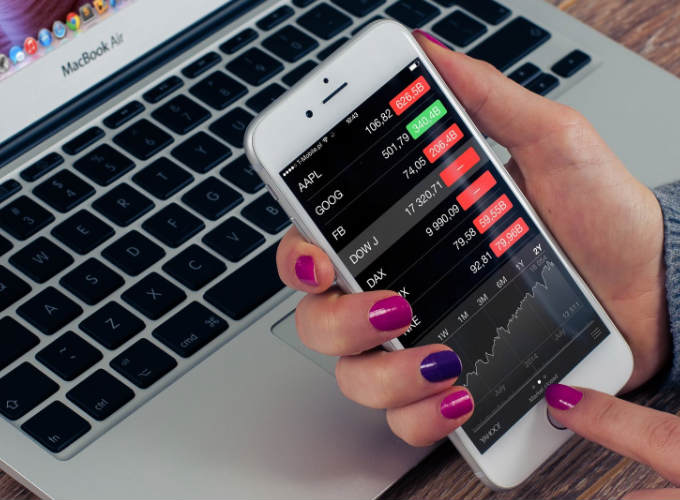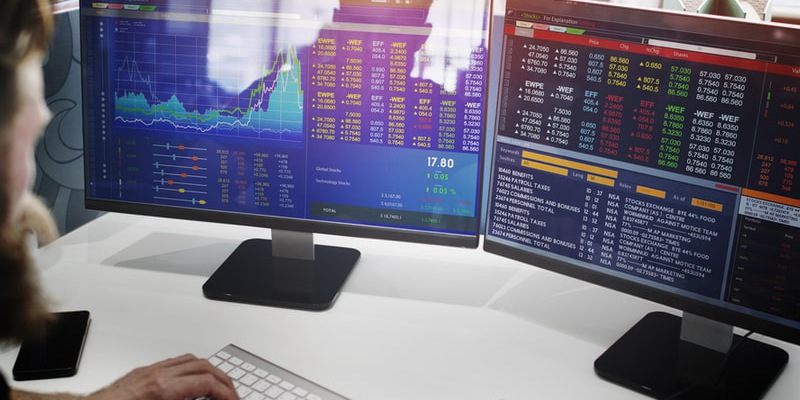Beginners Guide to ASX Day Trading (Australia)

The Australian Securities Exchange (ASX) is one of the world’s leading financial market exchanges, operating markets for a large range of asset classes that include stocks/equities, fixed-income instruments, and commodities.
Viewed as a global exchange leader, the ASX ranks among the top five exchanges worldwide with a total market capitalization of around $2 trillion.
Many traders are interested in getting into day trading, so can you day trade on the ASX?
Day Trading on the ASX
Day trading is the practice of making profits through the daily buying and selling of forex, commodities, derivatives, CFDs, and shares. Positions are closed at the end of the day to start fresh the following morning when the markets open.
The practice of day trading is a skill that takes time, focus, and dedication to education, along with a specific mindset.
The process involves taking advantage of small micro-movements in the market through fast decisions that require a large number of trades.
You can day trade on the ASX. The ASX offers many products for trade, including shares, indices, bonds, hybrid securities, ETFs, ETPs, managed funds, warrants, options, index derivatives, interest rate derivatives, grains derivatives, energy derivatives, and market-making arrangements.
While some of these are longer-term investments, many appeal to day traders seeking to make profits on daily market volatility, such as stocks.
Things You Should Know
1. Is day trading legal in Australia?
Day trading is legal in Australia. Many local brokers provide services. But make sure you trade with trusted and regulated providers. For example, Mitrade is authorized and regulated by the Australian Securities and Investments Commission (ASIC).
2. Is it safe to hold volatile stocks overnight?
This is not a good idea, especially if you use margin for trading. Volatility stocks tend to gap up and down. If the stock moves against you, you may be notified of a margin call. This means that you need to deposit more funds or sell other securities to make up for the loss.
3. Is day trading considered a form of gambling?
Day trading focuses on profiting from tiny price fluctuations within a day. As a result, some people think of it as gambling rather than investment. I believe, though day trading is volatile, it does not mean that it is gambling, it is just a trading style.
4. Can you day trade with $100?
Yes, many brokers in Australia accept margin trading, and opening an account to trade usually just costs $100.
- Gainers & Losers
- Forex
- Commodities
- Indices
- Shares
- Name
- Buy
- Sell
- Change
7 Steps to Day Trading (Australia)
Following are 7 steps day traders can take to engage in day trading on the ASX Australia:
1 Choose the Right Broker
Choosing the right broker involves an assessment of each broker’s transaction fees, platform features, and security measures.
● Clarify your needs Trading platforms vary between brokers, so before you start, take a moment to figure out what is most important to you in a trading platform. Your investment goals and trading experience will help you make the best decision.
● Broker Fees Fees are a very important consideration for day traders that make a large number of trades because multiple transactions may cut into their profits if fees are high.
● Margin Trading Margin trading involves obtaining credit provided by the broker that enables the trader to take large positions. It offers the large advantage of increased profits while at the same time magnifying losses, making it appropriate for experienced investors only.
● Deposit and Withdrawal Procedures Deposit and withdrawal procedures for moving funds into and out of a brokerage account are particularly important for many traders. Prior to setting up an account, many traders should carefully review the deposit, withdrawal, and funds settlement terms of the broker under consideration.
● Customer Service Customer support for most brokerages is offered through several ways that can include telephone, email or online chat. Online reviews often provide useful information from other users regarding brokerage customer support.
● Regulation Along with all the considerations mentioned above is investor safety and security. It is very important to choose a broker that is registered with the Australian Securities and Investment Commission (ASIC) - Australia's integrated corporate, markets, financial services, and consumer credit regulator.
Trade US stocks, currencies, and more on over 300 markets from your phone
Step1: Create an account online
Step2:Search the markets to trade, such as BTC/USD, AUD/USD
Step3:Open a long or short position
Step4: Set up your position size, take profit, stop-loss, etc.
Step5:Confirm the trade
Mitrade is an ASIC-regulated (AFSL398528) Forex and CFD broker, based in Melbourne Australia, offering trading on over 300 financial instruments via the simplified trading platform.
CFD is a T+0 margin trading product, you can go long or go short. No matter the market moves, you have opportunities for risky returns from markets fluctuating.

For example, If you think the gold price will go up in future days, you can buy 0.01 lot of gold, you will deposit about 20 dollars according to the current price. If the market price meets your expectation, you may profit from the price rising.
Mitrade also provides you protection against negative balances, allowing you to control the trading risk and trade with peace of mind.
If you are starting or want something more straightforward, you can try the free demo account ( $5000 virtual funds).
2 Choosing the best markets for day trading in Australia
The most popular day trading markets globally are forex, futures, CFDs, and stocks. The ASX offers many of these investment instruments including shares, bonds, indices, ETFs, hybrid securities, ETPs, warrants, managed funds, options, interest rate derivatives, index derivatives, grains derivatives, market-making arrangements and energy derivatives.
Trading hours at the ASX commence at 10:00 a.m. and end at 4:00 p.m., Monday to Friday.
On trading days, pre-opening takes place between 7:00 a.m. and 10:00 a.m. and during this time brokers can enter orders into the system online, which are queued according to price-time priority. The actual trades do not take place until the market officially opens.
Stocks/Shares
There are over 2000 stocks listed on the ASX, allowing investors to buy part ownership of an ASX-listed company.
Futures/CFDs
Futures and CFDs are very popular with day traders. They are an agreement between a buyer and a seller to buy or sell a certain amount of an underlying asset at a specific price on a future date.
Indices
Day trading indices are similar to share trading and are confined to the restrictions of operating hours of the market. The main difference is that when someone trades indices they are trading on a group of shares rather than just one company.
3 Trading Preparation
Every trader has a different routine to prepare for the day ahead. Many take time to review the previous day’s trades or any trades that were left open.
Traders also go over any news to get updated on the current events of the market, including reading any news they believe may cause market volatility.
This will enable them to gauge overall investment sentiment for the day and to make a plan based on predictions for how the markets will move. This should form part of an overall trading strategy for taking immediate action once the trading session opens.
You can work with Mitrade's trading tools (such as Strategy / Economic Calendar / News ) to explore the trading possibilities when the market fluctuates.▼▼▼

4 Determine The Best Day Trading Times
Unlike the 24-hour forex market, the ASX has a set amount of trading times as mentioned above. According to their website, pre-opening starts at 7 a.m., the official opening is at 10 a.m., and markets close at 4 p.m.
5 Learn Trading Psychology
Trading psychology is very important for traders, especially with regards to controlling their emotions so they make rational decisions.
Trading in general requires a set of skills concerning the ability to evaluate a company's fundamentals, determine stock trends and other technical skills. Day traders require some of these, however the most important is their mindset and being able to contain emotion, think quickly and exercise discipline.

Many experienced traders will say that the two main emotions to control are fear and greed. The inability to keep these two checked may result in making snap decisions that can result in serious losses. The understanding of these factors will give traders the discipline and objectivity required to take advantage of market conditions and to make the best decisions.
6 Create a Day Trading Strategy
There are many strategies for day trading. Here is a summary of all the elements a trader must take into consideration:
1. Set Risk Level
The first step is to set a level of risk and determine the maximum loss threshold per trade or trading day. For many this ranges from around 1% to 5% of the portfolio, meaning that if they lose that amount at any point, they will close their positions, take a break, and re-assess their plan.
2. Set Goals
Goal setting is very important in trading. It involves the setting of realistic profit targets, risk/reward ratios, and the minimum risk/reward a trader will accept.
3. Create Exit Rules
Before commencing trading, most traders clarify buy signals and exit rules. Losses are inevitable for most traders and professional traders will lose more trades than they win. Through the management of their profits and losses, they can average out their earnings and make a profit.
Before entering a trade, the trader must know their exit points write down the stop loss point, and follow that plan. Accordingly, each trade should have a profit target, and the trader should sell a portion of their position at that point, moving the stop loss for the rest of the position if desired.
4. Create Entry Rules
Since exits are more important than entries, this rule comes next. The trader needs to clarify a good point to enter a trade based upon any predetermined signals or events. Many automated trades are based upon these rules, and the goal of the day trader is to try to beat the other players in the market.
5. Performance Analysis
At the close of the trading day, traders need to record their trades in a journal to analyze their strategy. That is outlined in the next step.
| ⬇ Download Mitrade, Trade stocks CFD with 0 commission |
7 Develop A Day Trading System and Journal
A day trading journal is a record used by traders to keep track of their trades so they can reflect upon their movements and evaluate their performance.
There are many reasons to keep a trading journal, including giving the trader the ability to identify weak and strong points in their strategy and to keep themselves accountable. This allows them to perfect their strategy and to implement their plans consistently.
How to Create a Trading Journal?
Creating a trading journal is fairly straightforward. Most traders use a spreadsheet or notebook to record information about the specific trades, the dates/times traded, and the success of those trades.
The trading journal is a very important first step taken when traders begin learning to trade, and it is vital to test different strategies and find the ideal individualized plan suitable for each trader.
How much money do I need to become a day trader?
This is a very difficult question to answer and depends on the type of trading. Recall how the main difference between day trading and investment is the time frame.
Day trading focuses on short-term investing to generate maximum profits while investing focuses on long-term investing to build wealth. This often requires a very large amount of capital in order to leverage micro-movements in the market.
Making profits in day trading depends on the amount available to trade and this is highly dependent on each investor.
What percent of day traders are successful?
According to an article in Forbes magazine, the success rate for day traders is estimated to be around only 10%. In the article, Cory Michael at Vantage Point Trading estimates that only “1% of [day] traders make money”.
How much do you make on average by day trading?
Profits made by day traders vary widely according to skill and the capital available to invest. The markets traded, instruments used, leverage employed and many other factors determine the upside potential of day trading activity.
Why do Day Traders Fail?
A lack of knowledge about the stock market is the reason most traders fail. Research, analysis, and many other factors tie into the success levels of traders, and all these come with time and trading experience.
Markets are wild these days, so mistakes will inevitably be made and there's nothing wrong with it. The important thing is to keep reviewing your strategies until you find the right ones that work for you.
You can consider practice trading with a demo account at a suitable brokerage before committing any real money to day trading.
* The content presented above, whether from a third party or not, is considered as general advice only. This article should not be construed as containing investment advice, investment recommendations, an offer of or solicitation for any transactions in financial instruments.
- Original
- Trading Analysis
Risk Warning: Trading may result in the loss of your entire capital. Trading OTC derivatives may not be suitable for everyone. Please consider our legal disclosure documents before using our services and ensure that you understand the risks involved. You do not own or have any interest in the underlying assets.





